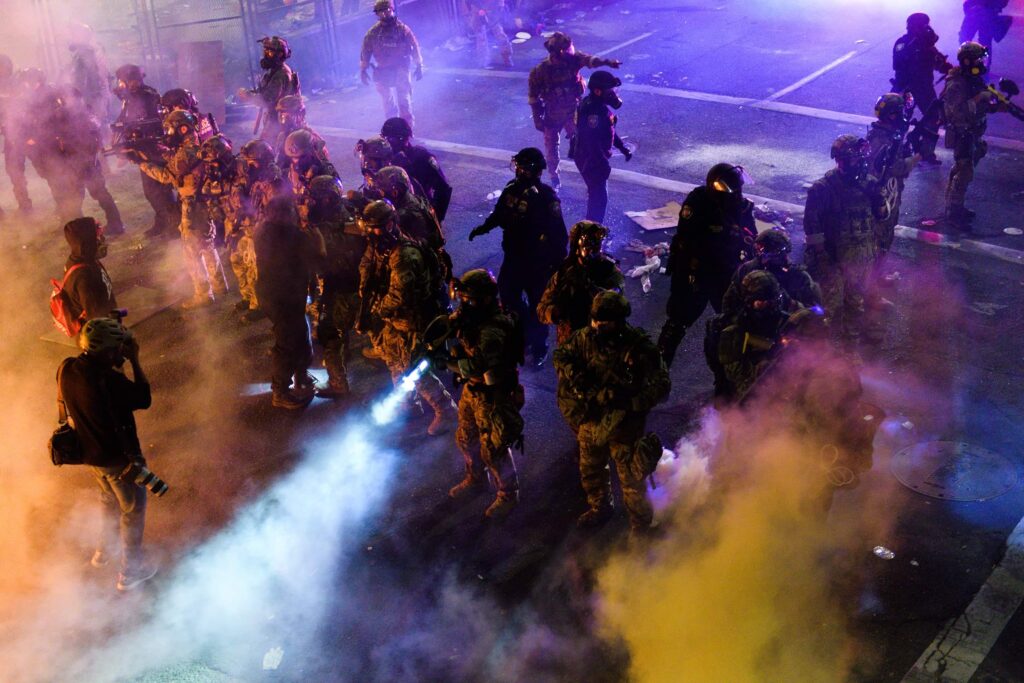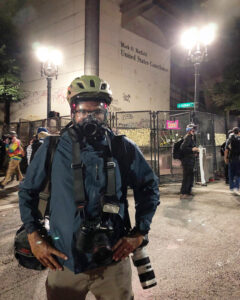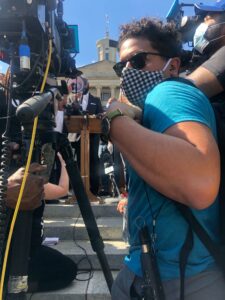Journalists face increasing attacks from law enforcement while covering racial justice protests

People across the country watched live as police officers handcuffed three members of a CNN crew who were covering protests in Minneapolis. In the video, you can see reporter Omar Jimenez follow a police officer’s instructions as he narrates the unfolding event.
Watching police target the crew on live television prompted uneasiness in journalists nationwide. Being a journalist comes with certain risks — but now, a growing number of journalists have experienced attacks from police while covering ongoing protests for Black lives.
Protesters, prompted by the May killing of George Floyd in Minneapolis, are calling for racial justice and an end to police brutality in the United States. And police, responding with tear gas and weapons, have been targeting both demonstrators and clearly identified journalists. From Jimenez’s detention to photographers in Portland being shot with rubber bullets, the attacks are raising new alarms for journalists and watchdog groups that advocate for a free press.
Linda Tirado, a freelance photojournalist, lost vision in her left eye after police shot her with a foam bullet on the third day of protests in Minneapolis. It was the first night Minnesota Governor Tim Walz set an 8 p.m. curfew. And while reporters were exempt from the curfew, that didn’t stop police from targeting them.
Tirado is one of multiple people who have recently lost an eye after being shot by police. And she’s one of many members of the press who have been injured by officers, even while clearly labeling themselves as members of the news media.
“It was the first night that the government had said explicitly that the press were exempt from the curfew order,” said Tirado. “You should be able to know that law enforcement will obey the law.”
On the same day that Tirado was hurt in Minneapolis, Cerise Castle was hit by a rubber bullet while reporting for KCRW in Los Angeles. She also sprained her ankle while running from police.
“I followed my training,” said Castle. “I did everything that I was taught to do. And law enforcement, for whatever reason, was disregarding the rights of the press.”
She said she hopes her experience encourages police departments to change for the better.
Associated Press photographer Marcio Jose Sanchez was also shot with a rubber bullet while covering recent protests against police brutality in Portland. He was hit in the groin by police officers who, he believes, confused him with a protester while he was taking photographs in the middle of the street.
“I didn’t think I was going to recover from it,” said Sanchez, who attributed his ability to continue working to a rush of adrenaline. “But I was able to shake it off after a few minutes.”
Since late May, there have been more than 600 acts of violence against journalists during protests against police brutality, according to the U.S. Freedom Press Freedom Tracker.
In July, as part of a lawsuit, the American Civil Liberties Union Foundation of Oregon secured a restraining order to prevent federal agents “from dispersing, arresting, threatening to arrest, or targeting force against journalists or legal observers at protests.” When they continued to use force, the ACLU asked a federal court to hold agents in contempt.
These recent attacks on journalists have been especially hard on journalists of color.
“We are not only covering this story, but we’re covering a story that directly affects us,” said Sergio Martinez-Beltran, who said he has grown used to experiencing discrimination from authorities in Nashville, where he covers politics for Nashville Public Radio.
Recently, Martinez-Beltran encountered obstacles from law enforcement twice in one week while reporting in a state office building.
Martinez-Beltran said they’re an example of the extra barriers journalists of color have to face when doing their jobs, even outside of covering protests. He is the only journalist of color that is part of the Capitol Hill press corps in Nashville and his experiences in the state building made him speak out about the difficulty that journalists of color face while reporting.

“What this shows is that, sometimes, if you’re a person of color, whatever you do, what you wear or how you conduct yourself or how you speak is not enough in these white spaces,” said Martinez-Beltran about his incidents in the state building and about Jimenez’s arrest in Minneapolis.
These attacks on journalists go directly against the freedom of press, making the job of journalists harder and more dangerous, according to Al Tompkins of the Poynter Institute, who said journalists provide the best documentation for all sides.
In a column for Poynter, Tompkins wrote that while all of these attacks would have made the news at any other moment in history, many journalists today are being injured without getting the attention they deserve.
“The public needs to know what the police are doing or not doing, and the way to do that is to allow journalists to be there,” Tompkins said about the role of journalists at protests.

Both Castle and Martinez-Beltran said they wish police would stop looking at the press as their enemy and that they are simply doing their job.
“If they do something good we are going to report it, if they do something bad we are going to ask more questions,” said Martinez-Beltran.
All of the journalists interviewed agreed that the environment of the recent protests felt different than others they have covered. Castle said that protesters seemed more united but police were more aggressive. Sanchez said that this was “one of the most dangerous assignments” he has had to do.
But despite the attacks, these journalists are not letting the situation get their spirits down.
“There’s nothing they can do to one of us that will stop all of us,” Tirado said. “The thing is journalism is not about any of us. We’re all out there doing the same job for the same reasons. And you cannot stop us from telling the truth.”
Adriana Morga is a senior at San Francisco State University, where she has studied photojournalism, political science and international relations. She has interned with Al Día, the Spanish language sister publication of the Dallas Morning News, and an on-call digital producer with KQED, an NPR member station in San Francisco. In the fall, she’ll serve as city news editor for San Francisco State University’s student newspaper, Golden Gate Xpress. Reach her at adrianamorgao [at] gmail [dot] com and on Twitter @adrianamorgao.